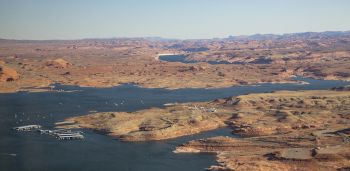O&M of a Reservoir: Difference between revisions
From ASDSO Dam Safety Toolbox
No edit summary |
No edit summary |
||
| (One intermediate revision by one other user not shown) | |||
| Line 12: | Line 12: | ||
|caption= | |caption= | ||
<!-- Add picture caption --> | <!-- Add picture caption --> | ||
Lake Powell, the second largest reservoir in the United States by water capacity. (National Park Service) | Lake Powell, the second largest reservoir in the United States by water capacity. | ||
(Image Source: National Park Service) | |||
}} | }} | ||
Latest revision as of 22:31, 18 July 2023

|
| Lake Powell, the second largest reservoir in the United States by water capacity.
(Image Source: National Park Service) |
Deposition of sediments in the reservoir is problematic as it reduces the reservoir’s potential storage capacity. These accumulated sediments can be removed in a variety of ways including sluicing through the bottom outlet of the dam (if one exists) and dredging.
“Existing reservoirs are routinely surveyed to determine sediment deposition and resulting loss of storage”.[1]
Best Practices Resources
![]() Hydrologic Engineering Requirements for Reservoirs (EM 1110-2-1420), USACE
Hydrologic Engineering Requirements for Reservoirs (EM 1110-2-1420), USACE
Citations:
Revision ID: 7320
Revision Date: 07/18/2023
